Page 3054 of 4083
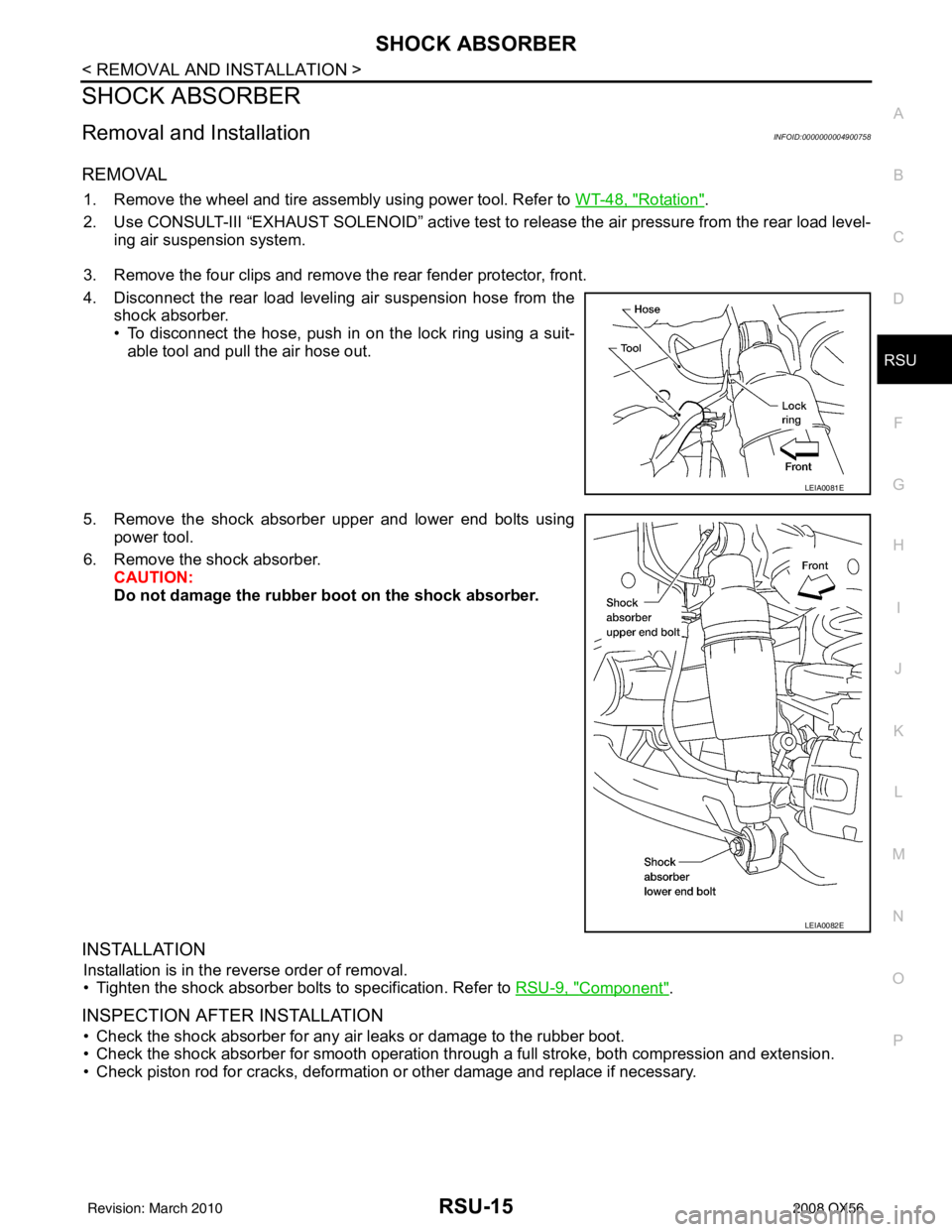
SHOCK ABSORBERRSU-15
< REMOVAL AND INSTALLATION >
C
DF
G H
I
J
K L
M A
B
RSU
N
O P
SHOCK ABSORBER
Removal and InstallationINFOID:0000000004900758
REMOVAL
1. Remove the wheel and tire assembly using power tool. Refer to WT-48, "Rotation".
2. Use CONSULT-III “EXHAUST SOLENOID ” active test to release the air pressure from the rear load level-
ing air suspension system.
3. Remove the four clips and remove the rear fender protector, front.
4. Disconnect the rear load leveling air suspension hose from the shock absorber.
• To disconnect the hose, push in on the lock ring using a suit-
able tool and pull the air hose out.
5. Remove the shock absorber upper and lower end bolts using power tool.
6. Remove the shock absorber. CAUTION:
Do not damage the rubber boot on the shock absorber.
INSTALLATION
Installation is in the reverse order of removal.
• Tighten the shock absorber bolts to specification. Refer to RSU-9, "
Component".
INSPECTION AFTER INSTALLATION
• Check the shock absorber for any air leaks or damage to the rubber boot.
• Check the shock absorber for smooth operation through a full stroke, both compression and extension.
• Check piston rod for cracks, deformation or other damage and replace if necessary.
LEIA0081E
LEIA0082E
Revision: March 2010 2008 QX56
Page 3056 of 4083
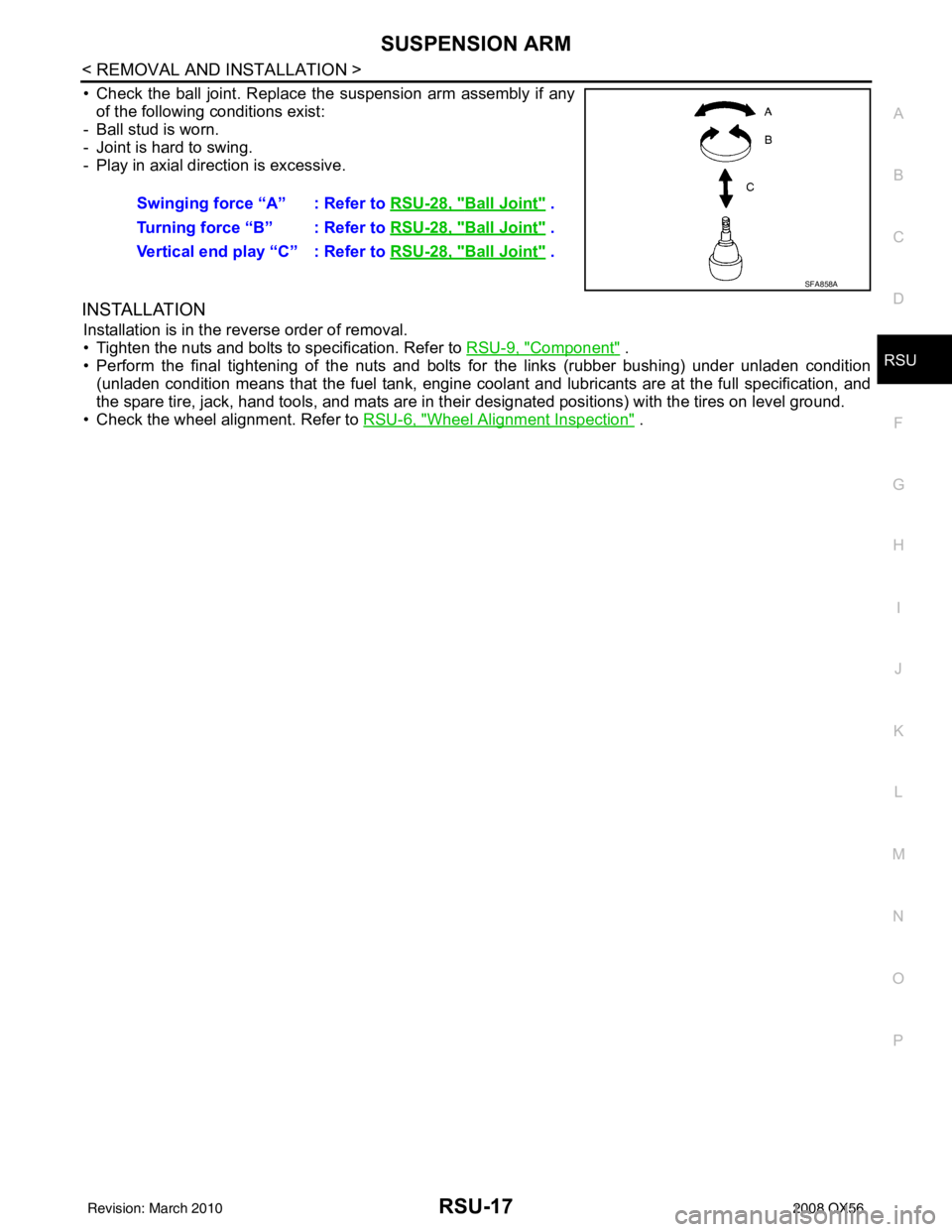
SUSPENSION ARMRSU-17
< REMOVAL AND INSTALLATION >
C
DF
G H
I
J
K L
M A
B
RSU
N
O P
• Check the ball joint. Replace the suspension arm assembly if any of the following conditions exist:
- Ball stud is worn.
- Joint is hard to swing.
- Play in axial direction is excessive.
INSTALLATION
Installation is in the reverse order of removal.
• Tighten the nuts and bolts to specification. Refer to RSU-9, "
Component" .
• Perform the final tightening of the nuts and bolts for the links (rubber bushing) under unladen condition
(unladen condition means that the fuel tank, engine cool ant and lubricants are at the full specification, and
the spare tire, jack, hand tools, and mats are in t heir designated positions) with the tires on level ground.
• Check the wheel alignment. Refer to RSU-6, "
Wheel Alignment Inspection" .
Swinging force “A” : Refer to RSU-28, "
Ball Joint" .
Turning force “B” : Refer to RSU-28, "
Ball Joint" .
Vertical end play “C” : Refer to RSU-28, "
Ball Joint" .
SFA858A
Revision: March 2010 2008 QX56
Page 3057 of 4083
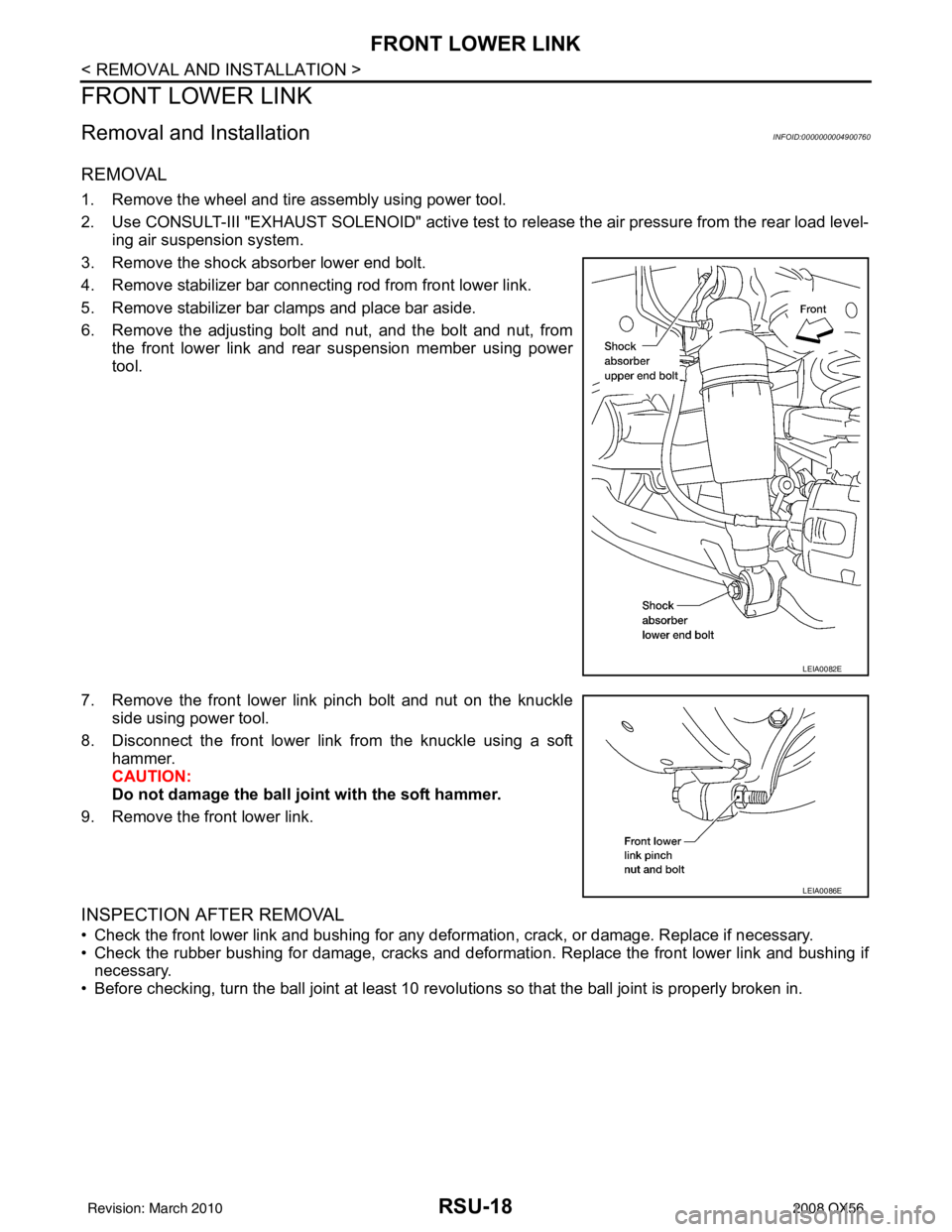
RSU-18
< REMOVAL AND INSTALLATION >
FRONT LOWER LINK
FRONT LOWER LINK
Removal and InstallationINFOID:0000000004900760
REMOVAL
1. Remove the wheel and tire assembly using power tool.
2. Use CONSULT-III "EXHAUST SOLENOID" active test to release the air pressure from the rear load level-
ing air suspension system.
3. Remove the shock absorber lower end bolt.
4. Remove stabilizer bar connecting rod from front lower link.
5. Remove stabilizer bar clamps and place bar aside.
6. Remove the adjusting bolt and nut, and the bolt and nut, from the front lower link and rear suspension member using power
tool.
7. Remove the front lower link pinch bolt and nut on the knuckle side using power tool.
8. Disconnect the front lower link from the knuckle using a soft hammer.
CAUTION:
Do not damage the ball joint with the soft hammer.
9. Remove the front lower link.
INSPECTION AFTER REMOVAL
• Check the front lower link and bushing for any deformation, crack, or damage. Replace if necessary.
• Check the rubber bushing for damage, cracks and deforma tion. Replace the front lower link and bushing if
necessary.
• Before checking, turn the ball joint at least 10 revolutions so that the ball joint is properly broken in.
LEIA0082E
LEIA0086E
Revision: March 2010 2008 QX56
Page 3058 of 4083
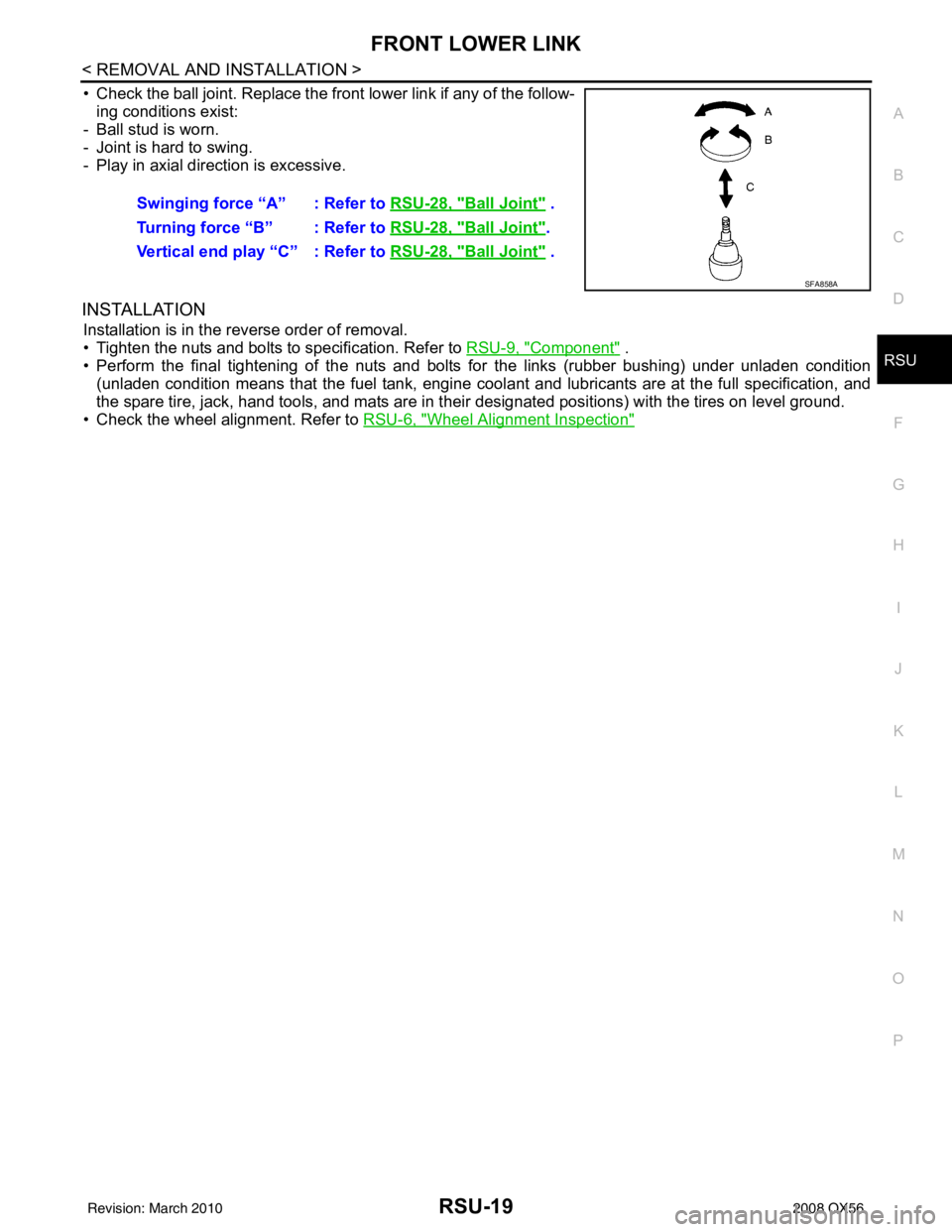
FRONT LOWER LINKRSU-19
< REMOVAL AND INSTALLATION >
C
DF
G H
I
J
K L
M A
B
RSU
N
O P
• Check the ball joint. Replace the front lower link if any of the follow- ing conditions exist:
- Ball stud is worn.
- Joint is hard to swing.
- Play in axial direction is excessive.
INSTALLATION
Installation is in the reverse order of removal.
• Tighten the nuts and bolts to specification. Refer to RSU-9, "
Component" .
• Perform the final tightening of the nuts and bolts for the links (rubber bushing) under unladen condition
(unladen condition means that the fuel tank, engine cool ant and lubricants are at the full specification, and
the spare tire, jack, hand tools, and mats are in t heir designated positions) with the tires on level ground.
• Check the wheel alignment. Refer to RSU-6, "
Wheel Alignment Inspection"
Swinging force “A” : Refer to RSU-28, "Ball Joint" .
Turning force “B” : Refer to RSU-28, "
Ball Joint".
Vertical end play “C” : Refer to RSU-28, "
Ball Joint" .
SFA858A
Revision: March 2010 2008 QX56
Page 3059 of 4083
RSU-20
< REMOVAL AND INSTALLATION >
REAR LOWER LINK & COIL SPRING
REAR LOWER LINK & COIL SPRING
Removal and InstallationINFOID:0000000004900761
REMOVAL
1. Remove the wheel and tire assembly using power tool. Refer to WT-48, "Rotation" .
2. Use CONSULT-III "EXHAUST SOLENOID" active test to release the air pressure from the rear load level-
ing air suspension system.
3. For removing the LH rear lower link and coil spring, remove the height sensor arm bracket bolt from the LH rear lower link.
4. Remove speed sensor harness and brackets from rear lower link.
5. Set a suitable jack to relieve the coil spring tension from the rear lower link.
WARNING:
Do not compress the coil sp ring when setting the jack.
6. Loosen the rear lower link adjusting bolt and nut connected to the rear suspension member, using power tool.
7. Remove the rear lower link bolt and nut from the knuckle using power tool.
LEIA0080E
LEIA0077E
LEIA0009E
LEIA0077E
Revision: March 2010 2008 QX56
Page 3060 of 4083
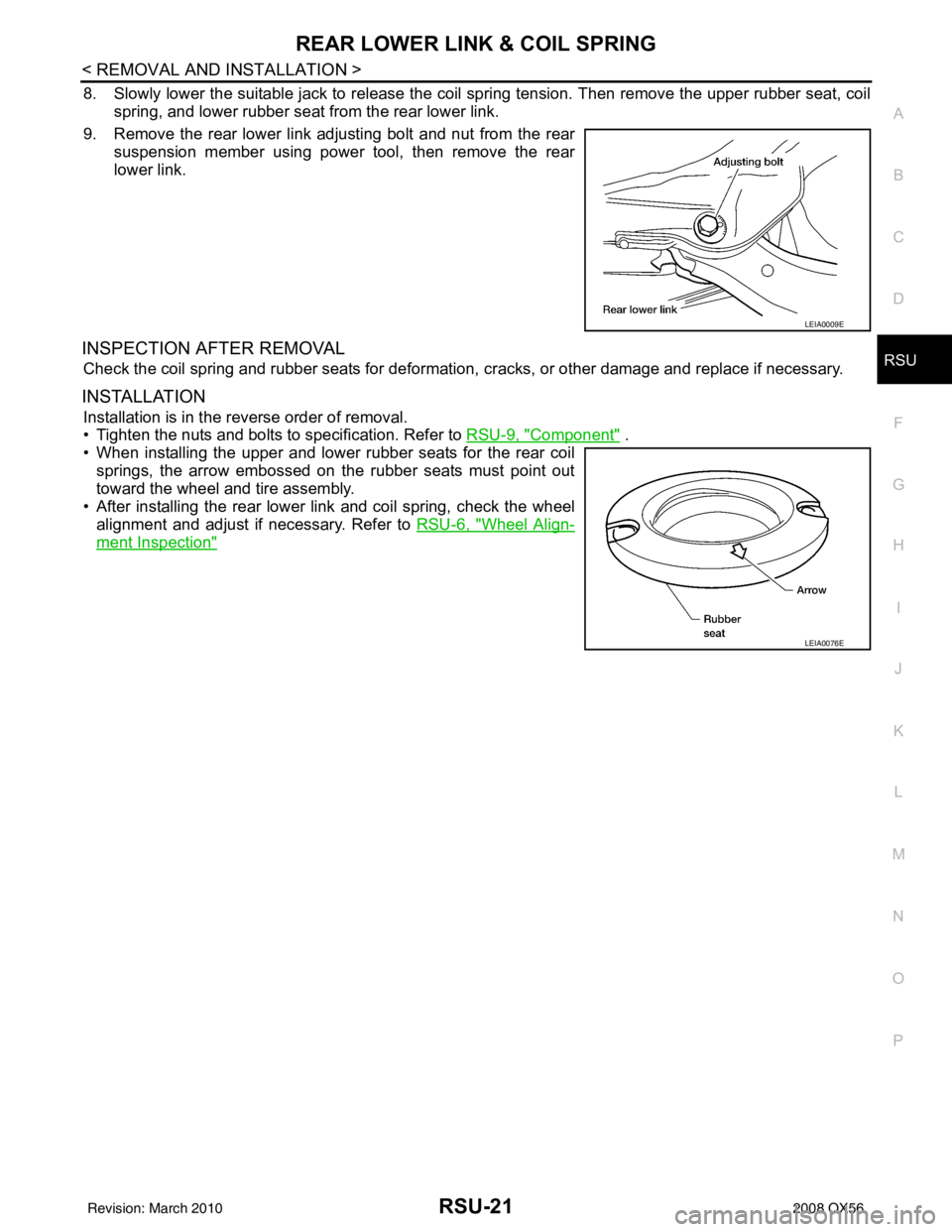
REAR LOWER LINK & COIL SPRINGRSU-21
< REMOVAL AND INSTALLATION >
C
DF
G H
I
J
K L
M A
B
RSU
N
O P
8. Slowly lower the suitable jack to release the coil spring tension. Then remove the upper rubber seat, coil spring, and lower rubber seat from the rear lower link.
9. Remove the rear lower link adjusting bolt and nut from the rear suspension member using power tool, then remove the rear
lower link.
INSPECTION AFTER REMOVAL
Check the coil spring and rubber seats for deformation, cracks, or other damage and replace if necessary.
INSTALLATION
Installation is in the reverse order of removal.
• Tighten the nuts and bolts to specification. Refer to RSU-9, "
Component" .
• When installing the upper and lower rubber seats for the rear coil springs, the arrow embossed on the rubber seats must point out
toward the wheel and tire assembly.
• After installing the rear lower link and coil spring, check the wheel alignment and adjust if necessary. Refer to RSU-6, "
Wheel Align-
ment Inspection"
LEIA0009E
LEIA0076E
Revision: March 2010 2008 QX56
Page 3066 of 4083
HEIGHT SENSORRSU-27
< REMOVAL AND INSTALLATION >
C
DF
G H
I
J
K L
M A
B
RSU
N
O P
1. Start the engine.
2. Use CONSULT-III to perform "STANDARD HEIGHT LEVEL" work support function.
3. Using data monitor of CONSULT-III, verify "HEIGT CALC" is at 0 mm.
4. Check the vehicle height. Refer to RSU-29, "
Wheelarch Height (Unladen*1)" . If vehicle height is not within
± 10 mm (0 ± 0.39 in) of the specification, perform the initialization procedure. Refer to SCS-7, "
CON-
SULT-III Function".
Revision: March 2010 2008 QX56
Page 3067 of 4083
RSU-28
< SERVICE DATA AND SPECIFICATIONS (SDS)
SERVICE DATA AND SPECIFICATIONS (SDS)
SERVICE DATA AND SPECIFICATIONS (SDS)
SERVICE DATA AND SPECIFICATIONS (SDS)
Wheel AlignmentINFOID:0000000001534650
Ball JointINFOID:0000000001534651
Camber
Degree minute (decimal degree)Minimum
0° 0 ′ (0 °)
Nominal - 0° 30 ′ (-0.5 °)
Maximum - 1° 0′ (-1.0 °)
Cross camber 0° 45 ′ (0.75 °)
To e - i n Distance (A - B)
Minimum
0 mm (0 in)
Nominal 3.3 mm (0.130 in)
Maximum 6.6 mm (0.260 in)
Cross toe 2 mm (0.079 in)
Angle (left, right)
Degree minute (decimal degree) Minimum
0° 0 ′ (0 °)
Nominal 0° 7 ′ (0.11 °)
Maximum 0° 14 ′ (0.22 °)
Cross toe 0° 8 ′ (0.14 °)
SFA234AC
Swinging force (measurement point: cotter pin hole of ball stud) “A” 11.4 - 145.5 N (1.16 - 14.8 kg, 2.56 - 32.7 lb)
Turning torque “B” 0.5 - 6.4 N·m (0.06 - 0.65 kg-m, 5 - 56 in-lb)
Vertical end play “C” 0 mm (0 in)
SFA858A
Revision: March 2010 2008 QX56